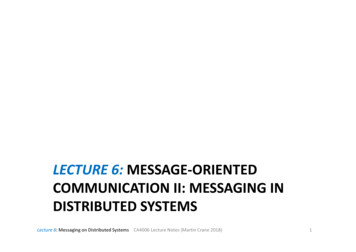
Transcription
Phys102 Lecture 23/24Light: Reflection and RefractionKey Points The Ray Model of Light Reflection and Mirrors Refraction, Snell’s Law Total internal ReflectionReferencesSFU Ed: 32-1,2,3,4,5,6,7.6th Ed: 23-1,2,3,4,5,6.
The Ray Model of LightLight very often travels in straight lines. Werepresent light using rays, which are straightlines emanating from an object. This is anidealization, but is very useful for geometricoptics.
ReflectionLaw of reflection: the angle of reflection(that the ray makes with the normal to asurface) equals the angle of incidence.
ReflectionWith diffusereflection, youreye sees reflectedlight at all angles.With specularreflection (from amirror), your eyemust be in thecorrect position.
Image Formation by a Plane MirrorWhat you see when you look into a plane (flat)mirror is an image, which appears to be behindthe mirror.
Image Formation by a Plane MirrorThis is called a virtual image, as the light doesnot go through it. The distance of the imagefrom the mirror is equal to the distance of theobject from the mirror.
32-2 Reflection; ImageFormation by a Plane MirrorExample 32-2: Howtall must a full-lengthmirror be?A woman 1.60 m tallstands in front of avertical plane mirror.What is the minimumheight of the mirror, andhow close must its loweredge be to the floor, if sheis to be able to see herwhole body? Assume hereyes are 10 cm below thetop of her head.
Conceptual Example 32-3: Is thephoto upside down?Close examination of the photographon the first page of this Chapter revealsthat in the top portion, the image of theSun is seen clearly, whereas in thelower portion, the image of the Sun ispartially blocked by the tree branches.Show why the reflection is not the sameas the real scene by drawing a sketchof this situation, showing the Sun, thecamera, the branch, and two rays goingfrom the Sun to the camera (one directand one reflected). Is the photographright side up?A) Yes.B) No.C) Can’t tell.
Formation of Images bySpherical MirrorsSpherical mirrors are shaped like sections ofa sphere, and may be reflective on either theinside (concave) or outside (convex).
Formation of Images bySpherical MirrorsParallel rays strikinga spherical mirror donot all converge atexactly the sameplace if the curvatureof the mirror is large;this is calledspherical aberration.
Formation of Images bySpherical MirrorsIf the curvature is small (small θ), thefocus is much more precise; the focalpoint is where the rays converge.
Formation of Images bySpherical MirrorsUsing geometry, we find that the focal length ishalf the radius of curvature:Spherical aberration can be avoided by using aparabolic reflector; these are more difficult andexpensive to make, and so are used only whennecessary, such as in research telescopes.
Formation of Images bySpherical MirrorsWe use ray diagrams to determine where animage will be. For mirrors, we use three keyrays, all of which begin on the object:1. A ray parallel to the axis; after reflection itpasses through the focal point.2. A ray through the focal point; after reflectionit is parallel to the axis.3. A ray perpendicular to the mirror; it reflectsback on itself.
Formation of Images bySpherical Mirrors
Formation of Images bySpherical MirrorsThe intersection of these three rays gives theposition of the image of that point on theobject. To get a full image, we can do thesame with other points (two points suffice formany purposes).
Formation of Images bySpherical MirrorsGeometrically, we can derive anequation that relates the objectdistance, image distance, andfocal length of the mirror:
Formation of Images bySpherical MirrorsWe can also find the magnification (ratio ofimage height to object height):The negative sign indicates that the image isinverted. This object is between the center ofcurvature and the focal point, and its image islarger, inverted, and real.
Formation of Images bySpherical MirrorsExample 32-4: Image in a concave mirror.A 1.50-cm-high diamond ring is placed 20.0cm from a concave mirror with radius ofcurvature 30.0 cm. Determine (a) theposition of the image, and (b) its size.
Formation of Images bySpherical MirrorsConceptual Example 32-5: Reversible rays.If the object in this figure is placed wherethe image is, where will the new image be?Figure 32-16 goes here.
Formation of Images bySpherical MirrorsIf an object is outside the center of curvature of aconcave mirror, its image will be inverted,smaller, and real.
Formation of Images bySpherical MirrorsExample 32-6: Object closer to concave mirror.A 1.00-cm-high object is placed 10.0 cm from aconcave mirror whose radius of curvature is 30.0cm. (a) Draw a ray diagram to locate (approximately)the position of the image. (b) Determine the positionof the image and the magnification analytically.
Formation of Images bySpherical MirrorsFor a convex mirror,the image is alwaysvirtual, upright, andsmaller.
Formation of Images bySpherical MirrorsProblem Solving: Spherical Mirrors1. Draw a ray diagram; the image is where the raysintersect.2. Apply the mirror and magnification equations.3. Sign conventions: if the object, image, or focal pointis on the reflective side of the mirror, its distance ispositive, and negative otherwise. Magnification ispositive if image is upright, negative otherwise.4. Check that your solution agrees with the ray diagram.
Formation of Images by SphericalMirrorsExample 32-7: Convexrearview mirror.An external rearviewcar mirror is convexwith a radius ofcurvature of 16.0 m.Determine the locationof the image and itsmagnification for anobject 10.0 m from themirror.
Index of RefractionIn general, light slowssomewhat whentraveling through amedium. The index ofrefraction of themedium is the ratio ofthe speed of light invacuum to the speedof light in the medium:
Refraction: Snell’s LawLight changes direction when crossing a boundary from one mediumto another. This is called refraction, and the angle the outgoing raymakes with the normal is called the angle of refraction.
Example 32-9: Apparent depth of a pool.A swimmer has dropped her goggles to the bottom of apool at the shallow end, marked as 1.0 m deep. But thegoggles don’t look that deep. Why? How deep do thegoggles appear to be when you look straight down intothe water?
Visible Spectrum and DispersionThe visible spectrum contains the fullrange of wavelengths of light that arevisible to the human eye.
Visible Spectrum and DispersionThe index of refraction of many transparentmaterials, such as glass and water, variesslightly with wavelength. This is how prismsand water droplets create rainbows fromsunlight.
Visible Spectrum and DispersionThis spreading of light into the fullspectrum is called dispersion.
Total Internal ReflectionIf light passes into a medium with a smaller index of refraction, theangle of refraction is larger. There is an angle of incidence for whichthe angle of refraction will be 90 ; this is called the critical angle:If the angle of incidence is larger than this, no transmissionoccurs. This is called total internal reflection.
Total Internal Reflection;Fiber OpticsOptical fibers also depend on totalinternal reflection; they are thereforeable to transmit light signals with verysmall losses.
Summary of Chapter 32 Light paths are called rays. Index of refraction: Angle of reflection equals angle of incidence. Plane mirror: image is virtual, upright, and thesame size as the object. Spherical mirror can be concave or convex. Focal length of the mirror:
Summary of Chapter 32 Mirror equation: Magnification: Real image: light passes through it. Virtual image: light does not pass through.
Summary of Chapter 32 Law of refraction (Snell’s law): Total internal reflection occurs when angle ofincidence is greater than critical angle:
Apply the mirror and magnification equations. 3. Sign conventions: if the object, image, or focal point is on the reflective side of the mirror, its distance is positive, and negative otherwise. Magnification is positive if image is upright, negative otherwise. 4. Check that your solution agrees with the ray diagram.










